The Plasmodium serine-type SERA proteases display distinct expression patterns and non-essential in vivo roles during life cycle progression of the malaria parasite
- PMID: 20039882
- PMCID: PMC2878606
- DOI: 10.1111/j.1462-5822.2009.01419.x
The Plasmodium serine-type SERA proteases display distinct expression patterns and non-essential in vivo roles during life cycle progression of the malaria parasite
Abstract
Parasite proteases play key roles in several fundamental steps of the Plasmodium life cycle, including haemoglobin degradation, host cell invasion and parasite egress. Plasmodium exit from infected host cells appears to be mediated by a class of papain-like cysteine proteases called 'serine repeat antigens' (SERAs). A SERA subfamily, represented by Plasmodium falciparum SERA5, contains an atypical active site serine residue instead of a catalytic cysteine. Members of this SERAser subfamily are abundantly expressed in asexual blood stages, rendering them attractive drug and vaccine targets. In this study, we show by antibody localization and in vivo fluorescent tagging with the red fluorescent protein mCherry that the two P. berghei serine-type family members, PbSERA1 and PbSERA2, display differential expression towards the final stages of merozoite formation. Via targeted gene replacement, we generated single and double gene knockouts of the P. berghei SERAser genes. These loss-of-function lines progressed normally through the parasite life cycle, suggesting a specialized, non-vital role for serine-type SERAs in vivo. Parasites lacking PbSERAser showed increased expression of the cysteine-type PbSERA3. Compensatory mechanisms between distinct SERA subfamilies may thus explain the absence of phenotypical defect in SERAser disruptants, and challenge the suitability to develop potent antimalarial drugs based on specific inhibitors of Plasmodium serine-type SERAs.
Figures

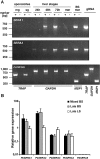
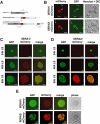
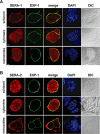
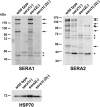
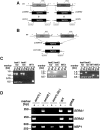

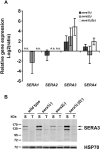
References
-
- Aoki S, Li J, Itagaki S, Okech BA, Egwang TG, Matsuoka H, et al. Serine repeat antigen (SERA5) is predominantly expressed among the SERA multigene family of Plasmodium falciparum, and the acquired antibody titers correlate with serum inhibition of the parasite growth. J Biol Chem. 2002;277:47533–47540. - PubMed
-
- Arisue N, Hirai M, Arai M, Matsuoka H, Horii T. Phylogeny and evolution of the SERA multigene family in the genus Plasmodium. J Mol E. 2007;65:82–91. - PubMed
-
- Delplace P, Fortier B, Tronchin G, Dubremetz JF, Vernes A. Localization, biosynthesis, processing and isolation of a major 126 kDa antigen of the parasitophorous vacuole of Plasmodium falciparum. Mol Biochem Parasitol. 1987;23:193–201. - PubMed
Publication types
MeSH terms
Substances
LinkOut - more resources
Full Text Sources
Other Literature Sources

